Drone Regulations Worldwide: A Guide to Flying Legally

Navigating the complex landscape of drone regulations has been one of the most challenging aspects of my decade-long journey as a drone pilot and consultant. After flying in many countries, I've learned that understanding local drone laws isn't just about avoiding fines—it's about responsible airmanship and ensuring our industry's sustainable growth. This comprehensive guide explores drone regulations across major regions, common regulatory elements, compliance strategies, and essential resources based on my extensive international flying experience.
Introduction to Drone Regulations
When drone flights just started becoming a thing, the regulatory landscape was like the Wild West—few specific rules existed, and those that did were often poorly enforced or understood. Even I remember conducting a commercial shoot in one of the Eastern European countries with nothing more than a verbal OK from a local police officer. Today, that same flight would require registration, certification, flight authorization, and possibly special permits—a transformation I've witnessed firsthand as our industry has matured.
Drone regulations serve several critical purposes that I've come to appreciate more deeply over the years:
- Safety: Preventing conflicts with manned aircraft and protecting people on the ground. I've had two close encounters with helicopters in my early flying days that made me deeply grateful for today's more structured airspace integration.
- Security: Addressing concerns about privacy, surveillance, and potential misuse. I've been questioned by security personnel numerous times, and proper documentation of regulatory compliance has always resolved these situations smoothly.
- Privacy: Protecting individuals from unwanted surveillance. The public's concerns about drones and privacy are legitimate—I now proactively inform nearby people about my flight intentions, which has transformed potentially hostile encounters into curious and supportive interactions.
- Environmental Protection: Minimizing disturbance to wildlife and sensitive ecosystems. After witnessing a drone cause a nesting bird colony to panic during breeding season, I became much more conscious of our potential environmental impact.
- Noise Management: Reducing noise pollution in residential and natural areas. The irritation drones can cause to those seeking peace in natural settings became clear to me when another pilot disrupted a peaceful mountain setting I was enjoying with my family.
Basic Regulatory Concepts
Understanding these fundamental concepts has helped me navigate regulations worldwide:
Registration Requirements
Most countries now require drone registration above certain weight thresholds:
- Operator Registration: Registering as a drone operator/owner. I maintain registrations in multiple jurisdictions and display my registration numbers on most of my drones.
- Aircraft Registration: Individual registration of specific drones. Some of my larger drones require individual registration with unique identifiers.
- Weight Thresholds: Typically ranging from 250g to 25kg, with different requirements at different weights.
Pilot Certification
Requirements for demonstrating pilot competency:
- Knowledge Tests: Understanding airspace, regulations, and flight principles. I've taken tests in multiple countries and find they've genuinely improved my knowledge of aviation concepts.
- Practical Assessments: Demonstrating flight skills and operational safety. These have been valuable for refining my emergency procedures and operational discipline.
- Categories of Certification: Different levels based on operation complexity and risk. I hold advanced certifications that allow me to conduct complex operations that would otherwise be prohibited.
Operational Limitations
Common restrictions on where and how drones can be flown:
- Maximum Altitude: Typically 120m/400ft AGL in most countries. I've occasionally received special authorizations to exceed these limits for specific projects.
- Visual Line of Sight (VLOS): Requirement to maintain visual contact with the drone. This remains one of the most significant operational limitations in my work.
- Distance from People: Minimum distances from uninvolved persons. These restrictions have shaped many of my shooting strategies and equipment choices.
- Airspace Restrictions: Prohibited areas around airports, government facilities, etc. I use multiple airspace information sources to ensure compliance, as these restrictions change frequently.
- Special Authorization Zones: Areas requiring explicit permission before flight.
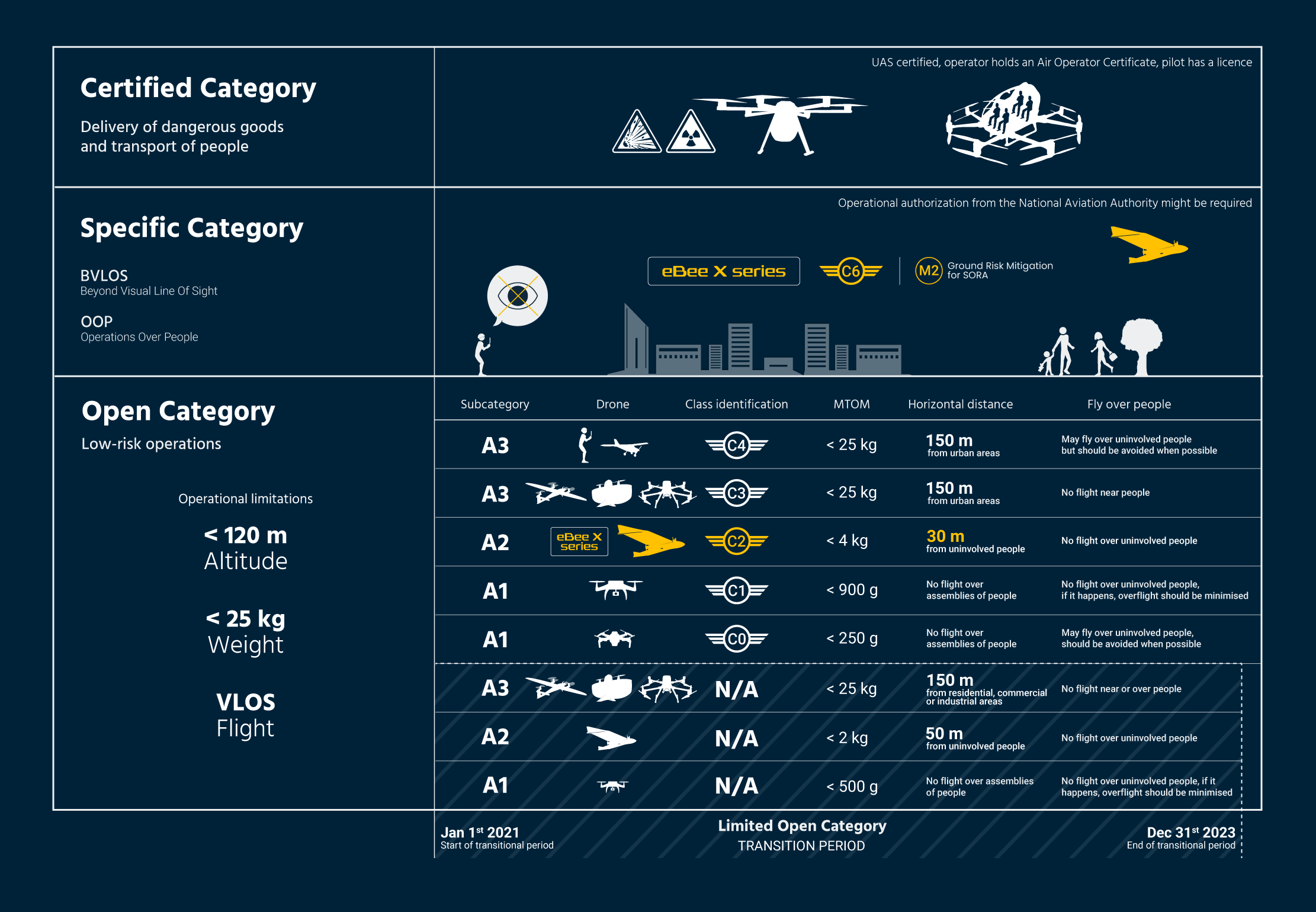
Major Regulatory Frameworks
Over the years, I've operated under all the major regulatory frameworks. Each has its unique approach and requirements.
FAA Regulations (United States)
Recreational Operations
- Exception 44809: Framework for hobby and recreational flying.
- TRUST Certificate: Required knowledge test for recreational pilots. A straightforward process that covers essential knowledge.
- Registration: Required for drones weighing 250g or more. You should register even your lightweight drones to ensure full compliance.
- Community-Based Organizations: Flying within the safety guidelines of recognized organizations.
Commercial Operations (Part 107)
- Remote Pilot Certificate: Required for commercial operations.
- Operating Rules: Daylight operations, maximum altitude, airspace restrictions, etc. These create a clear framework that makes compliance straightforward.
- Airspace Authorizations: LAANC system for near real-time approvals.
- Waivers: Process for exemptions from specific regulations.
Recent Developments
- Remote ID: Requirements for drones to broadcast identification and location information.
- Operations Over People: New framework allowing certified drones to operate over people. This has opened up new shooting possibilities in urban environments.
- BVLOS Developments: Progress toward routine beyond visual line of sight operations.
EASA Regulations (European Union)
Operation Categories
- Open Category: Lower risk operations without authorization requirements. Most of my European flying falls under this category, specifically A2 operations.
- Specific Category: Medium risk operations requiring authorization. I've conducted several operations under this category using standard scenarios.
- Certified Category: Higher risk operations under rules similar to manned aviation. I haven't yet operated in this category but am preparing for future projects that will require it.
Subcategories and Requirements
- A1/A2/A3 Subcategories: Different requirements based on drone weight and operation type. I've found the A2 category (drones under 4kg) to be the most practical for my professional work.
- C0-C4 Drone Classifications: Product standards for drones.
- Remote Pilot Competency: Different levels of required training and examination. The standardized EU certificates have simplified my operations across member states.
Implementation Timeline
- Transition Period: Gradual implementation of full requirements. I've been adapting my equipment and certifications throughout this period.
- National Differences: Despite harmonization, some variations exist between member states. I still research country-specific rules before traveling within the EU.
- U-Space Development: European UTM system for drone traffic management.
UK Regulations (Post-Brexit)
The UK system, which has diverged somewhat from EASA:
- Open/Specific/Certified Categories: Similar structure to EASA but with UK-specific implementation.
- GVC and A2 CofC: UK-specific pilot qualifications.
- Registration with CAA: UK operator ID requirements. The annual renewal process is straightforward but must be tracked separately from EU requirements.
Other Significant Frameworks
Australia (CASA)
- Excluded Category: Operations with lower regulatory requirements.
- ReOC: Remotely Piloted Aircraft Operator's Certificate for commercial operations. More complex than some systems but provides good operational flexibility.
- Remote Pilot Licence (RePL): Certification for commercial pilots.
Canada (Transport Canada)
- Basic/Advanced Operations: Two-tiered system based on operation risk.
- RPAS Certificate: Knowledge requirements for different operation types.
- RPAS Safety Assurance: Drone certification requirements.
China (CAAC)
- Cloud-Based UAS Management System: Real-time monitoring and geofencing.
- Pilot Licensing System: Comprehensive requirements for commercial operations. The theoretical knowledge requirements are among the most demanding I've seen so far.
- Real-Name Registration: Required for all drones over 250g. The verification process can be challenging for non-residents but is manageable with proper documentation.

Common Regulatory Elements Across Jurisdictions
Despite the differences between regulatory frameworks, I've identified several common elements that appear in most systems. Understanding these commonalities has helped me adapt quickly when flying in new countries.
Weight-Based Categories
Nearly all regulatory systems use drone weight as a primary classification factor:
- Micro Drones (typically <250g): Minimal regulations. My sub-250g drones have been invaluable for international travel due to their reduced regulatory burden.
- Small Drones (typically 250g-25kg): Standard recreational and commercial regulations apply. The bulk of my professional work uses drones in the 1-5kg range.
- Large Drones (typically >25kg): Extensive regulations similar to manned aircraft. I've operated these only occasionally for specialized heavy-lift applications.
No-Fly Zones and Restricted Areas
Universal restrictions on where drones can operate:
- Airports and Heliports: Typically 5-8km exclusion zones. I always research these carefully as the specific distances vary between countries.
- Government and Military Facilities: Strict prohibition on overflights. I've learned to identify these on aviation charts, as they're not always obvious on standard maps.
- Critical Infrastructure: Power plants, prisons, etc. These restrictions are not always well-publicized but can carry serious penalties for violations.
- National Parks and Protected Areas: Varying restrictions based on local regulations. I always contact park authorities directly, as online information is often outdated.
- Temporary Restrictions: Emergency situations, public events, VIP movements. These can appear with little notice and override normal permissions.
Operational Limitations
Standard restrictions that appear in most regulatory frameworks:
- Maximum Altitude: Typically 120m/400ft above ground level. I use terrain-aware flight planning to maintain this separation even over variable terrain.
- Visual Line of Sight: Requirement to see the drone with unaided vision. This remains one of the most significant operational constraints worldwide.
- Minimum Distance from People: Restrictions on flying near uninvolved persons. These vary widely but are universal in concept.
- Prohibited Operations: Restrictions on flying over crowds, moving vehicles, etc. I've developed specific techniques to work within these limitations while still achieving creative objectives.
- Weather Minimums: Restrictions on flying in poor visibility or high winds. I build weather contingency days into all my international shooting schedules.
Registration and Identification
Requirements to identify drones and their operators:
- Operator Registration: Registering as a drone pilot/operator. I maintain a spreadsheet of my various operator IDs and their renewal dates.
- Physical Marking: Displaying registration information on the drone. I use standardized labels that include all my international registration numbers.
- Electronic Identification: Broadcasting identity and position information. Remote ID requirements are becoming increasingly common, and I've upgraded my fleet accordingly.
- Documentation Requirements: Carrying proof of registration and certification. I keep digital and physical copies of all my documentation organized by country.
Insurance Requirements
Coverage for potential damages and liability:
- Liability Insurance: Required in many jurisdictions, especially for commercial operations. I maintain a global policy with specific endorsements for countries with unique requirements.
- Coverage Minimums: Specified minimum coverage amounts. These vary significantly—from approximately $750,000 in some countries to over $1.5 million in others.
- Proof of Insurance: Documentation requirements. I carry standardized certificates that meet the requirements of multiple jurisdictions.
| Regulatory Element | United States (FAA) | European Union (EASA) | United Kingdom (CAA) | Australia (CASA) | Canada (TC) |
|---|---|---|---|---|---|
| Micro Drone Threshold | <250g | <250g | <250g | <250g | <250g |
| Registration Required | ≥250g | ≥250g | ≥250g | >250g commercial | >250g |
| Recreational Knowledge Test | TRUST | Varies by category | Flyer ID | No | Basic exam for >250g |
| Commercial Certification | Part 107 | A2 CofC/GVC | A2 CofC/GVC | RePL | Basic/Advanced cert |
| Maximum Altitude | 400ft AGL | 120m AGL | 120m AGL | 120m AGL | 400ft AGL |
| VLOS Requirement | Yes | Yes | Yes | Yes | Yes |
| Insurance Requirement | No (recommended) | Yes | Yes | No (recommended) | Yes |
| Remote ID | Required | Phasing in | Phasing in | Not yet | Not yet |
| Night Operations | Allowed with lighting | Allowed with lighting | Allowed with lighting | Special approval | Advanced operations |
| Operations Over People | With certified drone | Restricted | Restricted | Special approval | With certified drone |
Comparison of key regulatory elements across major frameworks based on my experience operating in these jurisdictions. Requirements may change, so always verify current regulations.
Regional Comparison of Regulations
Through my international flying experience, I've observed significant regional variations in regulatory approaches. Understanding these differences has been crucial for my global operations.
North America
United States
- Regulatory Approach: Technology-friendly with clear pathways for commercial operations. I've found the FAA system to be relatively straightforward for professional work.
- Enforcement: Moderate to strong, with significant penalties for violations. I've witnessed several enforcement actions at popular tourist destinations.
- Unique Aspects: LAANC system for instant airspace authorization, strong emphasis on Remote ID.
Canada
- Regulatory Approach: Risk-based system with basic and advanced operations. I appreciate the clarity of this approach for different types of work.
- Enforcement: Moderate, with focus on education.
- Unique Aspects: Strong focus on pilot knowledge testing, National Parks generally prohibit recreational use.
Mexico
- Regulatory Approach: Developing system with increasing restrictions.
- Enforcement: Variable, stronger in tourist areas. I've been checked for documentation at popular archaeological sites but rarely elsewhere.
- Unique Aspects: Permit requirements for commercial filming, restrictions near archaeological sites. Obtaining commercial permits requires advance planning but is manageable with local assistance.
Europe
European Union (EASA Countries)
- Regulatory Approach: Harmonized, risk-based system across member states. The standardization has greatly simplified my operations across Europe.
- Enforcement: Variable by country, generally moderate to strong. I've experienced everything from casual conversations to formal document inspections.
- Unique Aspects: Standardized pilot certificates valid across member states, U-space development. The cross-recognition of certifications has eliminated a major administrative burden.
United Kingdom
- Regulatory Approach: Similar to EU but with UK-specific implementation. The divergence from EU rules has been manageable but requires attention to detail.
- Enforcement: Moderate, with increasing focus on education and compliance. The police drone units I've interacted with have been knowledgeable and professional.
- Unique Aspects: Strong focus on operator competency, specific registration system. The practical assessment requirements are more rigorous than many other systems.
Non-EU European Countries
- Regulatory Approach: Varies widely, some aligning with EASA, others with unique systems. I research each country individually before traveling.
- Enforcement: Highly variable. I've experienced everything from no apparent enforcement to detailed documentation checks.
- Unique Aspects: Often require temporary permits for visitors. I typically allow 2-4 weeks to obtain these permits before traveling.
Asia-Pacific
Australia
- Regulatory Approach: Well-developed system with commercial flexibility.
- Enforcement: Moderate, with strong focus on education. CASA's educational resources are among the best I've encountered.
- Unique Aspects: Strong focus on commercial operator certification, restricted areas clearly defined. The ReOC system provides good operational flexibility once established.
New Zealand
- Regulatory Approach: Risk-based system with straightforward rules.
- Enforcement: Moderate, with focus on education. The emphasis is clearly on helping pilots operate safely rather than punitive measures.
- Unique Aspects: Strong focus on landowner permission, airspace tools well-developed. The requirement to obtain explicit landowner permission occasionally presents logistical challenges.
Japan
- Regulatory Approach: Strict regulations with clear permission processes. The system is formal but predictable once understood.
- Enforcement: Strong, particularly in urban areas.
- Unique Aspects: Specific weight thresholds different from other regions, dense population creates many restricted areas. The 100g threshold for certain requirements is lower than most other countries.
China
- Regulatory Approach: Comprehensive system with real-time monitoring. The most technologically controlled system I've seen so far.
- Enforcement: Very strong, with technical enforcement through geofencing. The geofencing is nearly impossible to circumvent with consumer drones.
- Unique Aspects: Real-name registration linked to Chinese cloud systems, extensive no-fly zones. Operating as a foreigner requires significant advance planning.
Middle East
United Arab Emirates
- Regulatory Approach: Strict regulations with clear permit systems. The system is rigorous but well-organized.
- Enforcement: Very strong, with significant penalties. I've heard of equipment confiscation for violations, though I've not experienced this personally.
- Unique Aspects: Extensive no-fly zones, specific permit requirements for each emirate. I typically work with local fixers to navigate the permit process.
Israel
- Regulatory Approach: Highly restrictive with security focus. One of the most security-conscious systems I've encountered.
- Enforcement: Very strong, with security services involvement. I've been questioned about my equipment even before attempting to fly.
- Unique Aspects: Security clearance may be required, extensive restricted areas. Professional operations generally require local partners with appropriate clearances.
Africa
South Africa
- Regulatory Approach: Well-developed system modeled partly on European regulations. One of the more structured systems on the continent.
- Enforcement: Moderate, stronger in tourist and urban areas. I've found enforcement to be professional and knowledgeable.
- Unique Aspects: Strong focus on commercial operator certification, specific restrictions in wildlife areas. The RPAS Operating Certificate process is comprehensive but manageable.
Kenya, Tanzania, and Wildlife Areas
- Regulatory Approach: Increasing restrictions, particularly in wildlife areas. Regulations have tightened significantly in recent years.
- Enforcement: Variable, but strong in national parks and reserves. Rangers are increasingly aware of drone regulations and actively enforce them.
- Unique Aspects: Special permits required for national parks, often with significant fees. These permits can take months to obtain and may require ministry-level approval.
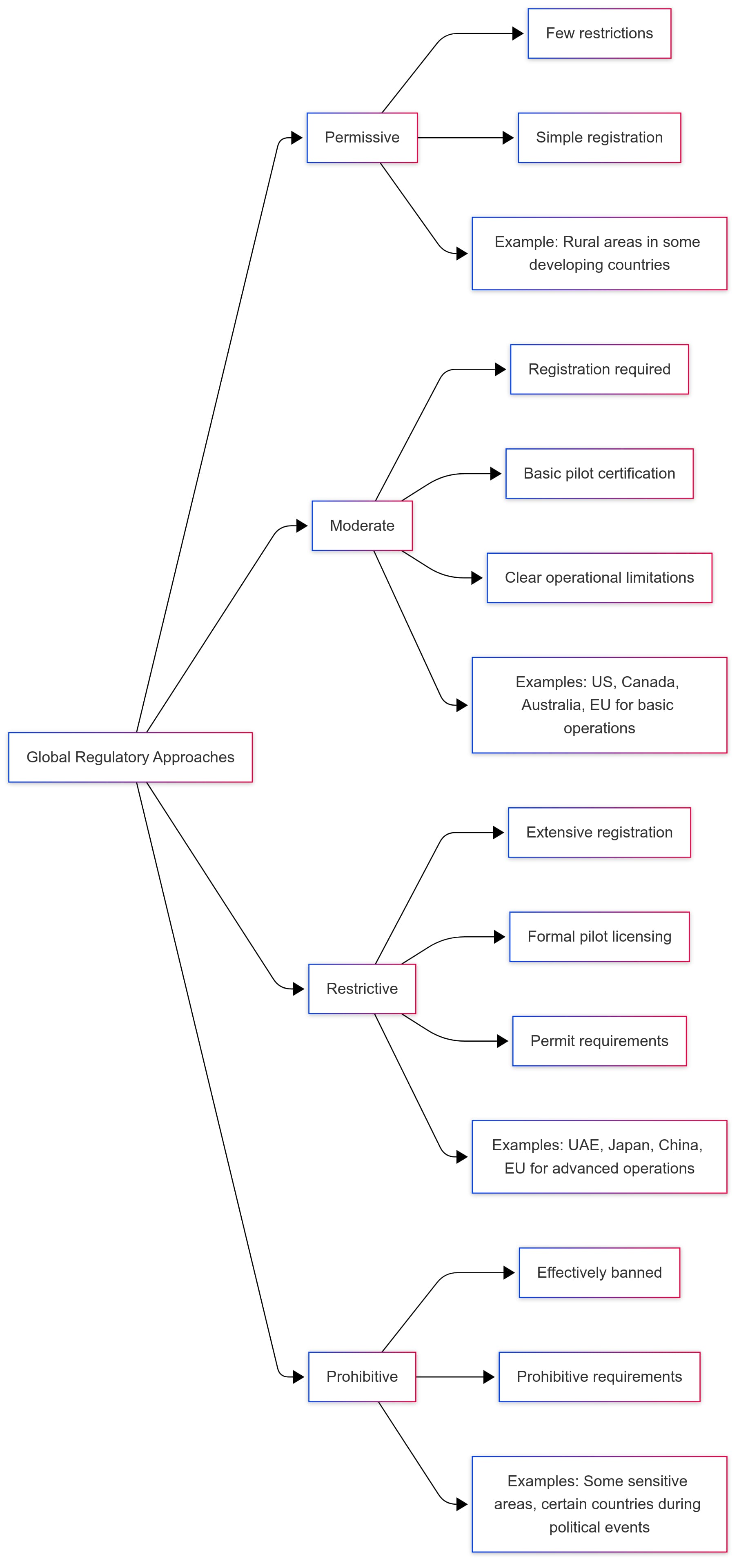
Tools for Navigating Regulations
Over the years, I've developed a toolkit of resources that help me navigate the complex regulatory landscape. These tools have saved me countless hours of research and helped prevent compliance issues.
Online Resources and Apps
Essential digital tools for regulatory compliance:
DroneMaps24
Website

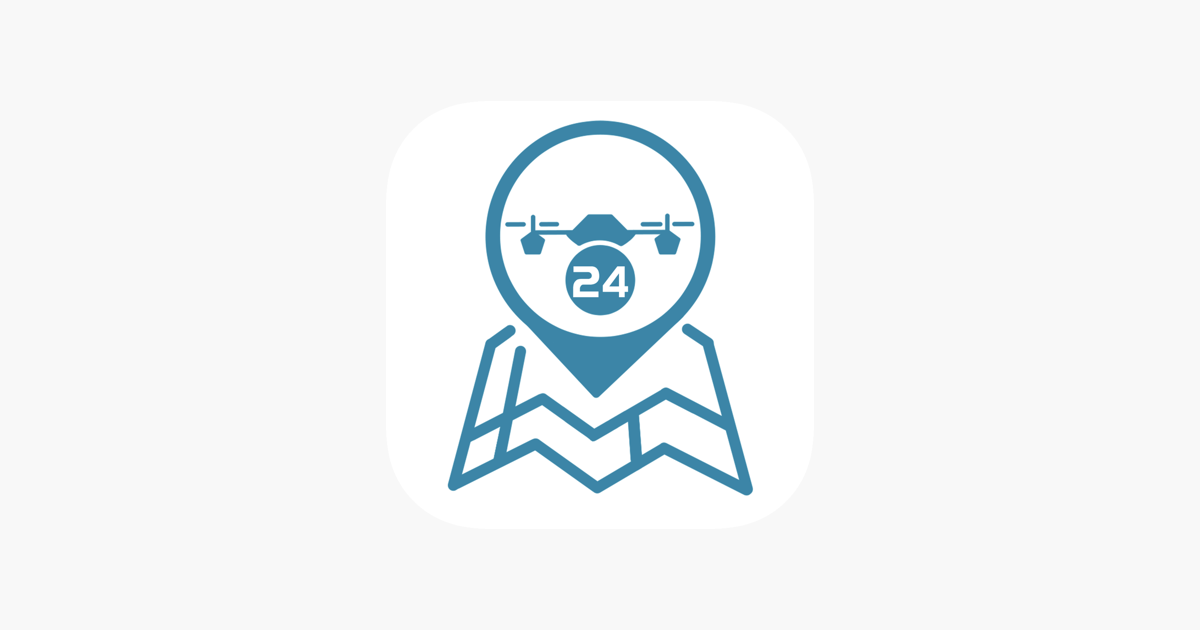
A comprehensive resource I use before every international trip.
Global coverage of drone regulations, no-fly zones, and requirements. The country-specific summaries have been invaluable for my international operations.
I've used DroneMaps24 in over 20 countries and found it to be consistently reliable and up-to-date. The ability to download country regulations for offline use has been particularly helpful in remote areas.
Drone-Made

An excellent resource for regulatory updates and industry developments.
Detailed guides to regulations, equipment reviews, and operational best practices. Their regulatory guides include nuances that aren't always covered in official documentation.
I regularly consult their country guides before international trips and have found their insights on local enforcement practices particularly useful.
Official Aviation Authority Apps and Websites
FAA DroneZone and B4UFLY (USA)

Essential for US operations. I use B4UFLY for quick checks and DroneZone for formal authorizations.
OpenSky (EU)

EASA's official app for drone pilots. The standardized EU interface works well across member states.
Altitude Angel (Global)

Provides airspace information worldwide. I use this as a supplementary source to verify information from other apps.
DJI Fly Safe/GEO System

Manufacturer-specific restrictions. I always cross-check these with official sources as they sometimes contain errors or outdated information.
Pre-Flight Planning Process
My systematic approach to regulatory compliance:
- Research Phase (Weeks/Months Before):
- Check country-specific regulations using DroneMaps24 and official sources
- Identify registration and certification requirements
- Apply for any necessary permits or authorizations
- Verify insurance coverage for the destination
- Pre-Trip Preparation (Days Before):
- Download offline maps and regulatory information
- Prepare documentation package (registrations, certifications, permits)
- Identify local emergency contacts and aviation authorities
- Check for any recent regulatory changes
- On-Site Assessment (Day of Flight):
- Verify local restrictions using multiple apps
- Check for temporary flight restrictions
- Assess local conditions and identify any unreported hazards
- Contact local authorities if clarification is needed
- Post-Flight Documentation:
- Log flights with relevant details
- Note any regulatory interactions or challenges
- Update personal database of location-specific information
- Report any discrepancies found in apps or resources
Documentation Management
My system for maintaining regulatory compliance documentation:
- Digital Organization: Cloud-based folder structure organized by country and document type. I can access all my documentation from anywhere in the world.
- Physical Documentation Kit: Laminated copies of essential documents for field use. I've found that physical documents are sometimes necessary when digital verification isn't possible.
- Renewal Tracking System: Calendar alerts for expirations and renewals. I set reminders 60, 30, and 14 days before any expiration.
- Local Contacts Database: List of regulatory contacts in frequently visited countries. Building relationships with regulatory officials has been invaluable for resolving unusual situations.
| Resource Type | Examples | Best For | Limitations |
|---|---|---|---|
| Official Aviation Authority Resources | FAA DroneZone, EASA Portal, CAA Drone Portal | Authoritative information, permits, registrations | Sometimes complex, may not be user-friendly |
| Third-Party Regulatory Apps | DroneMaps24, Altitude Angel, AirMap | User-friendly interface, consolidated information | May have occasional inaccuracies, require verification |
| Manufacturer Apps | DJI Fly, DJI GEO | Equipment-specific restrictions, simple interface | Often conservative, may not reflect all official exceptions |
| Community Resources | Drone-Made, UAV Coach, forums | Practical insights, experience-based advice | Unofficial, may contain outdated information |
| Local Fixers/Consultants | Country-specific drone service providers | Navigating complex local requirements, obtaining permits | Cost, variable quality of service |
Comparison of regulatory navigation resources based on my experience using them internationally. I typically use multiple resources to cross-verify information.
Compliance Strategies for International Operations
Based on my experience flying commercially in dozens of countries, I've developed these strategies for navigating international drone regulations effectively.
Research and Preparation
Thorough preparation has prevented countless regulatory issues in my international operations:
- Advance Research Timeline: I begin researching regulations at least 8 weeks before international projects—some permits can take 6+ weeks to process.
- Multiple Information Sources: I never rely on a single source for regulatory information. Cross-verification between official sources, third-party apps, and local contacts is essential.
- Local Regulatory Contacts: Whenever possible, I establish direct communication with regulatory authorities. Email confirmation of requirements provides valuable documentation if questions arise in the field.
- Permit Application Strategy: For complex permissions, I submit applications with comprehensive operation details, safety measures, and contingency plans. Demonstrating thorough preparation has helped me obtain permissions for otherwise restricted operations.
Documentation and Communication
Proper documentation has resolved numerous potential issues during my international operations:
- Comprehensive Documentation Package: I maintain a digital and physical portfolio including:
- Drone registrations (all relevant jurisdictions)
- Pilot certifications and licenses
- Insurance certificates (with country-specific endorsements)
- Operation-specific permits and authorizations
- Flight logs and maintenance records
- Company credentials and references
- Local Stakeholder Communication: Before flying in new locations, I inform:
- Property owners and managers
- Local police or security (when appropriate)
- Other airspace users if operating near heliports or small airports
- Nearby sensitive facilities
- Visual Identification: My drones and control stations display:
- Registration numbers from relevant jurisdictions
- Contact information
- QR code linking to digital copies of certifications
Risk Management Approach
Adopting a risk-based mindset has allowed me to operate successfully under diverse regulatory frameworks:
- Conservative Interpretation: When regulations are ambiguous, I adopt the more restrictive interpretation. This approach has prevented numerous potential violations.
- Buffer Zones: I add personal buffer zones beyond regulatory minimums:
- +30m to minimum distance from people requirements
- -30m from maximum altitude limits
- +1km to airport exclusion zones
- Temporal buffers (arriving early, allowing extra time)
- Tiered Operation Planning: For each project, I develop:
- Primary plan (ideal scenario within standard regulations)
- Secondary plan (alternative approach if primary faces restrictions)
- Minimal viable plan (what must be accomplished within strictest interpretation)
- Continuous Monitoring: During operations, I maintain awareness of:
- Changing weather conditions that may affect regulatory compliance
- Unexpected gatherings of people that may trigger restrictions
- Aircraft activity that may require yielding the airspace
- Security or law enforcement presence that may indicate concerns
Working with Local Partners
Local expertise has been invaluable for my international operations:
- Local Drone Operators: Partnering with local operators who understand:
- Nuances of local regulations and enforcement
- Unwritten rules and cultural considerations
- Relationships with relevant authorities
- Location-specific challenges and solutions
- Fixers and Production Services: In countries with complex bureaucracy, I work with:
- Production service companies with drone experience
- Fixers with regulatory connections
- Local guides familiar with sensitive areas
- Translators for regulatory meetings
- Legal Consultation: For major projects in countries with complex regulations, I consult with:
- Aviation attorneys familiar with drone regulations
- Local legal experts who understand enforcement practices
- Insurance specialists for appropriate coverage
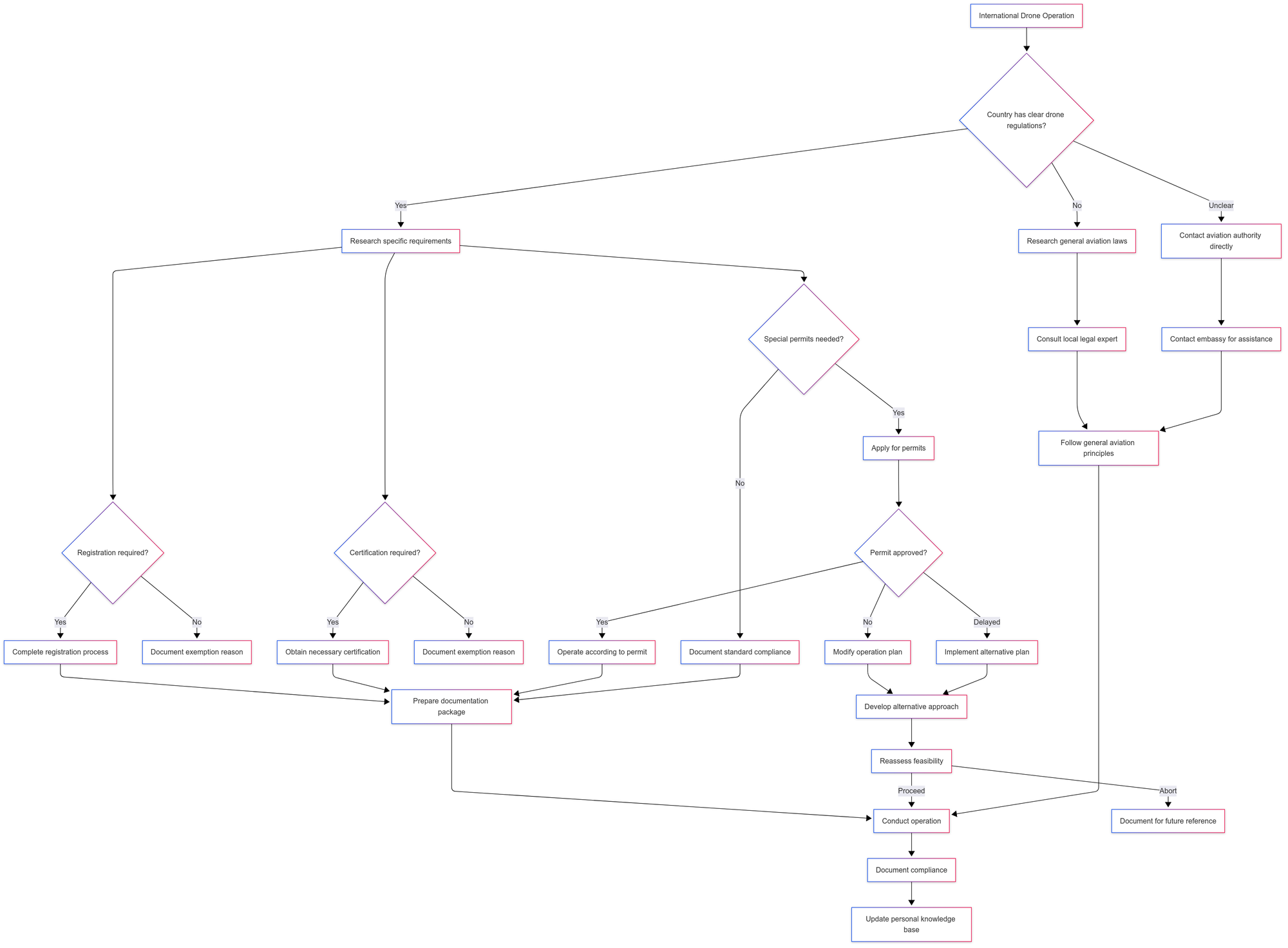
Future Trends in Drone Regulations
Based on my involvement with regulatory development and discussions with aviation authorities, here's where I see drone regulations heading:
Harmonization and Standardization
- ICAO Framework: Development of international standards for drone operations. I've participated in industry consultations for these standards and am optimistic about their potential to simplify international operations.
- Regional Alignment: Neighboring countries adopting compatible systems. I've already seen this beginning in regions like Southeast Asia and parts of Africa.
- Industry Standards: Manufacturer compliance with international requirements. This is gradually eliminating the need to use different drones in different regions.
Risk-Based Approach Expansion
- Operation-Centric Regulations: Further shift from aircraft categories to operation risk. This approach has already allowed me to conduct previously restricted operations by demonstrating appropriate safety measures.
- Specific Operation Risk Assessment (SORA): Standardized methodology for evaluating operation safety. I've used SORA successfully to obtain approvals for complex operations in the EU.
- Performance-Based Standards: Focus on capabilities rather than prescriptive requirements. This trend is allowing more innovative approaches to safety management.
UTM Integration
- Unmanned Traffic Management: Development of systems to integrate drones into airspace. I've participated in several UTM trials and seen the potential for dramatically expanded operations.
- Electronic Identification: Universal requirements for remote ID. I've already upgraded my fleet to comply with these emerging requirements.
- Strategic Deconfliction: Automated coordination of drone operations. This will eventually eliminate many of the current restrictions on simultaneous operations.
Expanded Operational Capabilities
- BVLOS Operations: Routine beyond visual line of sight flights. This will transform many commercial applications, particularly in inspection and delivery.
- Autonomous Operations: Reduced direct pilot involvement. I'm already testing systems with increased autonomy under appropriate authorizations.
- Urban Air Mobility: Framework for passenger-carrying drones. While still emerging, these regulations will eventually create an entirely new transportation category.
Privacy and Security Focus
- Privacy Regulations: Specific requirements beyond general data protection laws. I've already implemented privacy impact assessments for sensitive operations.
- Counter-Drone Measures: Legal framework for drone detection and mitigation. These systems are becoming increasingly common at sensitive facilities.
- Cybersecurity Requirements: Standards for secure control and data links. I've upgraded my equipment to incorporate enhanced encryption and security features.
Pro Tips from My Experience
After navigating drone regulations in dozens of countries, here are some of my hard-earned insights that you won't find in official documentation:
- Maintain a "Clean Record": I've found that a history of compliance makes a significant difference when applying for special permissions. Aviation authorities often consider past behavior when evaluating applications for complex operations.
- Document Everything: I record all regulatory interactions, including names, dates, and summaries of conversations. This documentation has resolved numerous potential issues when questions arise about permissions.
- Build Relationships: I make a point of establishing professional relationships with regulatory officials. These connections have been invaluable for obtaining clarification on ambiguous rules and expediting urgent permissions.
- Join Industry Associations: I maintain membership in drone industry groups in regions where I frequently operate. These organizations often have direct channels to regulatory authorities and advance notice of upcoming changes.
- Prepare for Scrutiny: I always assume I'll be questioned about my operations and prepare accordingly. Having comprehensive documentation immediately available has transformed potentially problematic encounters into routine checks.
- Consider Cultural Context: I adapt my approach to local customs and expectations. In some regions, formal letters of introduction carry significant weight, while in others, in-person meetings are essential for establishing credibility.
- Budget for Compliance: I include regulatory compliance costs in all project budgets. These expenses—including registrations, certifications, permits, and sometimes local consultants—can be substantial but are essential for legal operation.
- Plan for Delays: I never schedule critical flights immediately after entering a new jurisdiction. Regulatory processes often take longer than officially stated, and building buffer time has saved numerous projects.
- Carry Backup Documentation: I maintain both digital and physical copies of all essential documents. In remote areas without reliable internet access, physical documentation has been crucial.
- Stay Informed: I subscribe to regulatory updates from aviation authorities in regions where I frequently operate. Advance knowledge of regulatory changes has allowed me to adapt my equipment and procedures proactively.
FAQ: Common Questions About Drone Regulations
How do I find the regulations for a specific country?
Based on my experience researching regulations worldwide:
- Official Sources: Always start with the national aviation authority's website. I've found that most now have dedicated drone sections, though the quality and clarity vary significantly.
- Consolidated Resources: Use tools like DroneMaps24 and Drone-Made for summaries and guidance. These have saved me countless hours of research.
- Diplomatic Resources: Check your country's embassy or consulate in the destination country. I've received valuable guidance from embassy staff in countries with unclear regulations.
- Industry Groups: Contact local drone associations or user groups. I've connected with local pilots through social media who have provided current information not yet reflected in official sources.
- Verification Process: Always verify information from multiple sources, as regulations change frequently. I make a point of confirming any information older than six months.
What should I do if regulations are unclear or contradictory?
This is a common challenge I've faced in many countries:
- Direct Contact: Reach out to the aviation authority directly. I've found that email inquiries with specific, clearly stated questions often receive helpful responses.
- Written Confirmation: Always try to get clarification in writing. I save all official correspondence as documentation of good-faith compliance efforts.
- Local Expertise: Consult with local drone operators or aviation attorneys. I've engaged local experts in countries with particularly complex or ambiguous regulations.
- Conservative Approach: When doubt remains, adopt the more restrictive interpretation. I've avoided numerous potential issues by erring on the side of caution.
- Document Your Diligence: Keep records of all attempts to clarify regulations. I've found that demonstrating thorough research and good-faith efforts to comply can be valuable if questions arise.
How do I handle drone travel across international borders?
Based on my extensive international travel with drone equipment:
- Customs Documentation: Research import requirements for drone equipment. I carry documentation showing the value and specifications of all equipment.
- Carnet Consideration: For professional equipment, an ATA Carnet may be necessary. I've used carnets for high-value equipment to avoid import duties and complications.
- Battery Regulations: Be aware of airline restrictions on lithium batteries. I always check the specific airline's current policy, as these change frequently and vary between carriers.
- Carrying vs. Shipping: Consider the relative risks of carrying equipment versus shipping it. For critical projects, I sometimes ship backup equipment separately to mitigate the risk of customs issues.
- Declare Appropriately: Always declare drone equipment at customs. I've found that attempting to avoid declaration often leads to more significant complications if the equipment is discovered.
What insurance do I need for international drone operations?
Insurance requirements vary significantly between jurisdictions:
- Liability Coverage: Most countries that require insurance specify minimum liability coverage. I maintain a global policy with high limits that satisfy requirements in most jurisdictions.
- Hull Insurance: Coverage for damage to your own equipment. I adjust my hull coverage based on the specific equipment I'm traveling with and the risk profile of the operation.
- Jurisdiction-Specific Endorsements: Some countries require specific policy language or local insurance providers. I work with a broker experienced in aviation insurance to obtain these when necessary.
- Commercial vs. Recreational: Different requirements often apply based on operation type. My commercial operations always carry higher coverage than technically required to provide additional protection.
- Proof of Insurance: Carry appropriate documentation of coverage. I maintain digital and physical certificates that specifically mention drone operations and coverage territories.
How do I stay updated on changing regulations?
Keeping current with evolving regulations is an ongoing challenge:
- Official Subscriptions: Sign up for regulatory updates from aviation authorities. I subscribe to email notifications from authorities in regions where I frequently operate.
- Industry News Sources: Follow drone industry publications and news sites. These often provide analysis and context for regulatory changes that official sources lack.
- Professional Networks: Participate in professional drone communities. I've received early information about regulatory changes through industry connections.
- Manufacturer Updates: Monitor updates from major drone manufacturers. Companies like DJI often provide guidance on regulatory changes that affect their products.
- Regular Review: Schedule periodic reviews of regulations in your operating areas. I conduct quarterly reviews of regulations in my primary operating regions and pre-trip reviews for less frequent destinations.
What are the consequences of non-compliance?
Based on observed enforcement actions and personal experience:
- Financial Penalties: Fines ranging from minor to severe. I've seen penalties ranging from approximately $100 to over $20,000 depending on the violation and jurisdiction.
- Equipment Confiscation: Temporary or permanent seizure of drone equipment. This can be particularly problematic for professional operators with specialized equipment.
- Criminal Charges: Possible in cases of serious violations. Flights near airports or sensitive government facilities can result in criminal prosecution in many jurisdictions.
- Operating Restrictions: Suspension or revocation of permits and licenses. These can affect your ability to operate commercially for extended periods.
- Reputation Damage: Professional and industry standing can be affected. In the relatively small professional drone community, reputation matters significantly for obtaining work and permissions.
Conclusion
Navigating the complex world of drone regulations has been one of the most challenging aspects of my professional journey. What began as a relatively unregulated field has evolved into a sophisticated regulatory environment that balances safety concerns with operational flexibility. While the increasing complexity can sometimes feel overwhelming, I've found that today's more mature regulations actually enable more types of operations with the right preparation and certification.
Understanding drone regulations isn't just about avoiding penalties—it's about being a responsible participant in the aviation ecosystem and ensuring our industry's sustainable growth. By approaching regulations with a professional mindset and investing time in proper research and compliance, you'll not only protect yourself legally but also contribute to the positive perception of drones in society.
The regulatory landscape will continue to evolve, likely becoming more standardized internationally while also expanding to accommodate new capabilities like beyond visual line of sight operations and autonomous flight. Staying informed and adaptable will be essential for anyone serious about drone operations, whether recreational or professional.
Whether you're flying locally or internationally, the effort invested in understanding and complying with regulations pays dividends in operational freedom, professional reputation, and peace of mind. I've learned many of these lessons through trial and error across six continents—hopefully, my experience can help you navigate this complex landscape more smoothly.
References and Further Reading
External Resources
- DroneMaps24 - Comprehensive global drone regulations resource
- DroneMaps24 iOS App - Mobile access to drone regulations worldwide
- Drone-Made - Practical guides to drone regulations and operations
- ICAO UAS Toolkit - International Civil Aviation Organization resources for unmanned aircraft systems
- FAA Drone Resources - United States Federal Aviation Administration drone information
- EASA Drone Categories - European Union Aviation Safety Agency drone regulations





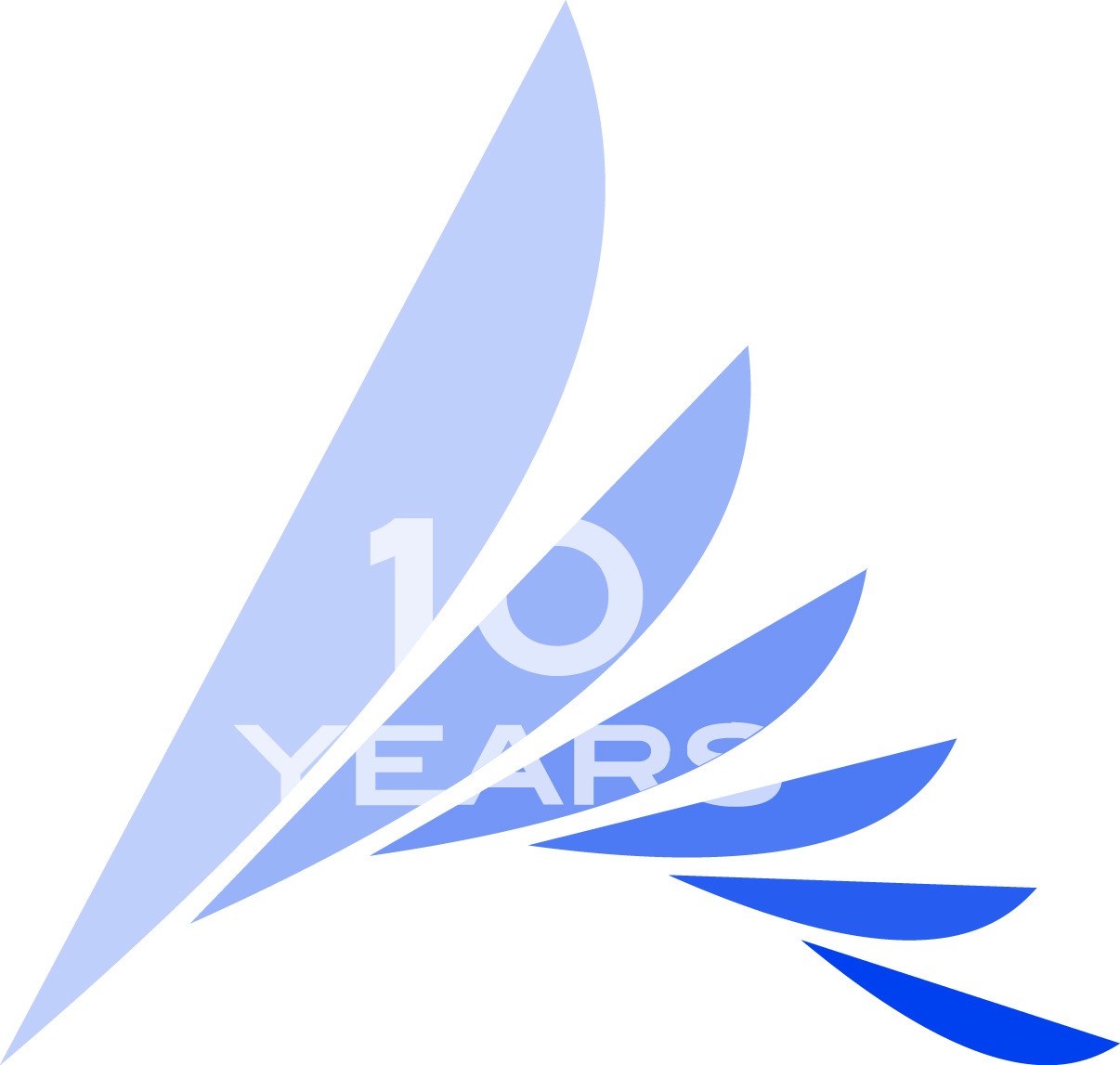


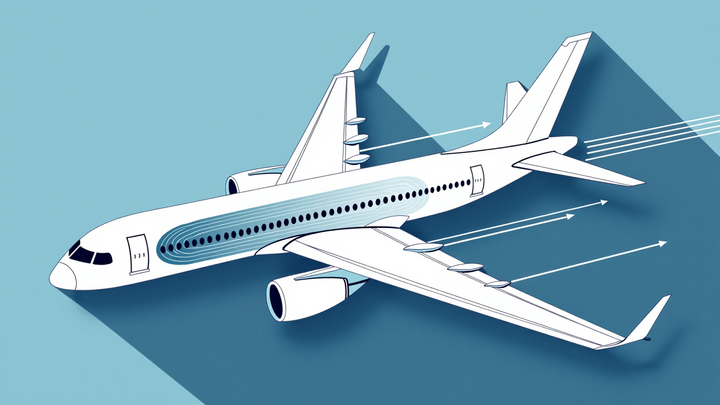

Comments ()